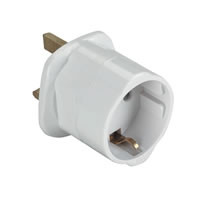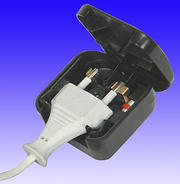Maybe I can pick the brains of some of you who actually understand electrical stuff - this is over my head and I am keen to identify the problem asap.
I initially thought I'd identified a problem with my guitar amp. Last night, when plugged in and playing through the amp connected to the mains, i picked up my iphone 5s, which was charging via usb plugged into my laptop, and the laptop itself is plugged into another mains outlet on the other side of the room. When picking up the charging phone with my right hand, which is aluminium, i noticed a non-painful but unmistakeable electrical tingling, NOT in my phone hand, but in my left hand on the guitar strings.
So I assumed it was the guitar side, went away and read a load of stuff about faulty guitar amps and became a bit paranoid that I need a new amp or at least a professional service for the existing one. I decided not to play connected to the amp again until the amp had been checked, as well as the mains outlets where this happened.
Fast forward to today, and I started to wonder if something else in the chain was at fault - when i remembered macbook pros are notorious for giving a mild electric sensation when plugged into the mains, and the user touches the metal casing while their person is grounded in some way.
I didn't think a phone charging via usb would be capable of doing anything similar - but according to various stories on the internet iphone 5s owners have reported similar mild shocks and/or tingling from their phone when connected and charging.
So, this time while holding my charging phone in my left hand (again connected via usb to my laptop, laptop itself plugged in to the mains, albeit a different outlet downstairs this time) I cautiously put the back of my hand against the radiator (ground as far as i understand) to see if the pattern repeated. I am fairly certain I felt the same kind of tingling building on the back of the radiator hand (equivalent of guitar hand last night), so immediately pulled my hand away to err on side of caution.
I then remembered my laptop charger has a mainland euro style plug (i think type e or type f) which i have plugged into a british three pin adaptor, which as far as I can tell does not sync up with the 'ground' or earth pin on the plug.
Could that be the culprit, or some combination, or could it be the house mains?
This is a bit of a splurge so apologies for that, like I say I am no electrician and might have everything back to front here - please forgive me if I am talking absolute rubbish but hopefully some of you will have some logical advice on how to eliminate the parts of the chain.
I initially thought I'd identified a problem with my guitar amp. Last night, when plugged in and playing through the amp connected to the mains, i picked up my iphone 5s, which was charging via usb plugged into my laptop, and the laptop itself is plugged into another mains outlet on the other side of the room. When picking up the charging phone with my right hand, which is aluminium, i noticed a non-painful but unmistakeable electrical tingling, NOT in my phone hand, but in my left hand on the guitar strings.
So I assumed it was the guitar side, went away and read a load of stuff about faulty guitar amps and became a bit paranoid that I need a new amp or at least a professional service for the existing one. I decided not to play connected to the amp again until the amp had been checked, as well as the mains outlets where this happened.
Fast forward to today, and I started to wonder if something else in the chain was at fault - when i remembered macbook pros are notorious for giving a mild electric sensation when plugged into the mains, and the user touches the metal casing while their person is grounded in some way.
I didn't think a phone charging via usb would be capable of doing anything similar - but according to various stories on the internet iphone 5s owners have reported similar mild shocks and/or tingling from their phone when connected and charging.
So, this time while holding my charging phone in my left hand (again connected via usb to my laptop, laptop itself plugged in to the mains, albeit a different outlet downstairs this time) I cautiously put the back of my hand against the radiator (ground as far as i understand) to see if the pattern repeated. I am fairly certain I felt the same kind of tingling building on the back of the radiator hand (equivalent of guitar hand last night), so immediately pulled my hand away to err on side of caution.
I then remembered my laptop charger has a mainland euro style plug (i think type e or type f) which i have plugged into a british three pin adaptor, which as far as I can tell does not sync up with the 'ground' or earth pin on the plug.
Could that be the culprit, or some combination, or could it be the house mains?
This is a bit of a splurge so apologies for that, like I say I am no electrician and might have everything back to front here - please forgive me if I am talking absolute rubbish but hopefully some of you will have some logical advice on how to eliminate the parts of the chain.







